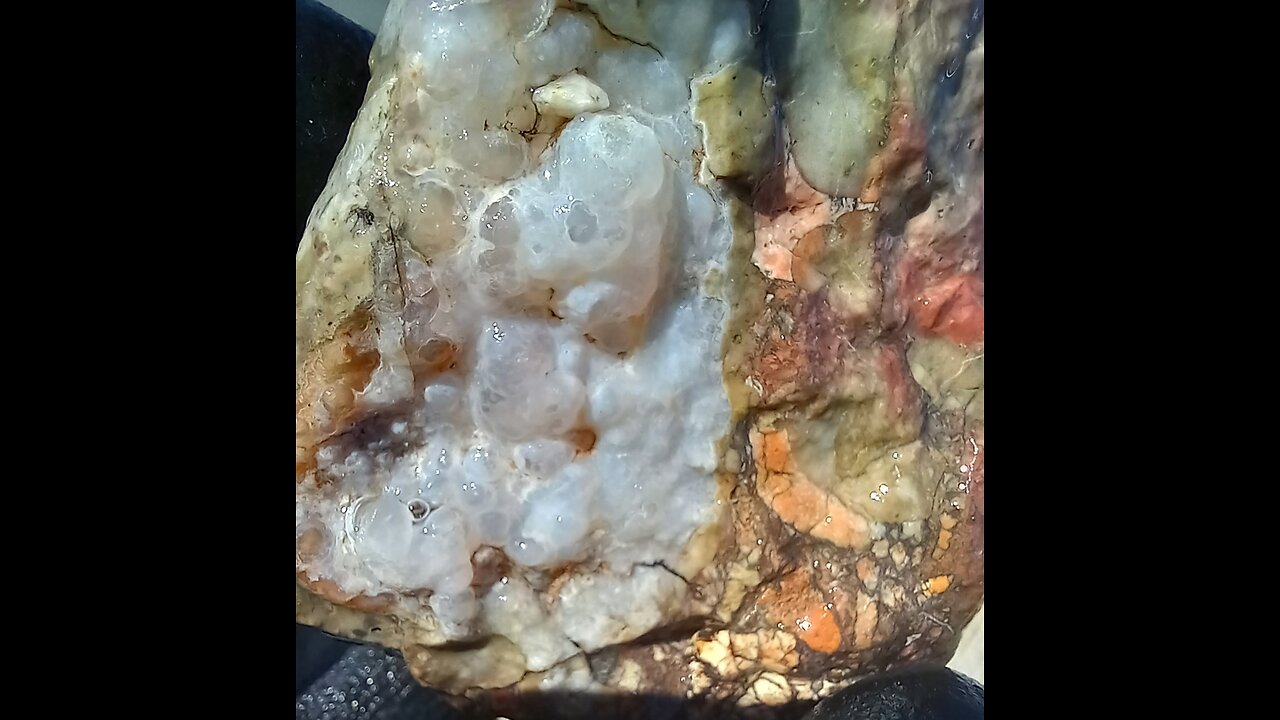Premium Only Content

Botryoital Opal w/ A Little of Everything!
Opal is a hydrated amorphous form of silica, with a water content typically between 3 and 21% by weight, most commonly around 6-10%. It's deposited at relatively low temperatures and can be found in the fissures of various rock types, including limonite, sandstone, rhyolite, marl, and basalt. Here's a deeper look into opal:
Types of Opal:
Precious Opal: Known for its "play-of-color," which is an optical phenomenon where colors flash or change as the angle of light or observation changes. This effect is due to the diffraction of light through the microscopic silica spheres within the opal.
Common Opal: Lacks the play-of-color and can come in a variety of colors like white, black, grey, yellow, orange, red, or brown. It's often referred to as "potch" when not gem-quality.
Fire Opal: Typically ranges in color from yellow to orange to red and can be transparent to translucent. Fire opals can exhibit play-of-color, but their name comes from the fiery body color.
Boulder Opal: A type of opal naturally attached to its host rock. It's often cut with the host rock to provide stability and to enhance the visual appeal.
Matrix Opal: The opal fills the cracks and cavities within the host rock, creating a network of opal that's visible on the surface.
Formation:
Primary Opal: Forms through the slow deposition of silica from groundwater in cavities or fractures of rocks.
Secondary Opal: Can form by weathering or alteration of other minerals, often in more superficial environments or through the action of silica-rich waters.
Locations:
Australia: The world's leading source, especially for precious opal, with significant deposits in places like Coober Pedy, Lightning Ridge, and White Cliffs.
Ethiopia: Known for its black opals and more recently discovered opal fields.
Mexico: Famous for fire opals.
Brazil: Produces a variety of opals, including crystal opal.
Properties:
Hardness: Typically ranges between 5.5 to 6.5 on the Mohs scale, though it can be softer if less hydrated or harder if more silica-rich.
Luster: Can range from waxy to resinous to vitreous.
Transparency: Varies from opaque to semi-translucent to transparent.
-
 15:49
15:49
Rethinking the Dollar
1 hour agoThis Crypto ‘Freeze Code’ Warning Changes Everything
502 -
 1:10:03
1:10:03
The Rubin Report
2 hours ago‘The View’s Sunny Hostin Tries to Shame John Fetterman Until He Puts Her in Her Place
89.8K44 -
 LIVE
LIVE
LFA TV
16 hours agoLIVE & BREAKING NEWS! | WEDNESDAY 11/12/25
3,220 watching -
 18:53
18:53
Professor Nez
1 hour agoDemocrats TURN on Chuck Schumer & BOOT HIM OUT of the Party!
7.31K6 -
 LIVE
LIVE
The Mel K Show
2 hours agoMORNINGS WITH MEL K - Dueling Narratives & Endless Distraction: Don’t Lose Focus! - 11-12-25
715 watching -
 LIVE
LIVE
The Shannon Joy Show
2 hours agoH1-B-Trayal! How Many Times Does Trump Have To Punch MAGA In The Face Before They Realize He’s Just Not That Into Them?
251 watching -
 1:56:53
1:56:53
Badlands Media
11 hours agoBadlands Daily: November 12, 2025 – Epstein Emails, COVID Lies & Constitutional Chaos
90.1K9 -
 43:54
43:54
VINCE
3 hours agoThomas Speciale: The Man Behind John Brennan's Meltdown | Episode 167 - 11/12/25 VINCE
73.4K118 -
 DVR
DVR
Nikko Ortiz
3 hours agoMILITARY FAILS AND KAREN ACTIVITIES... |Rumble Live
25.2K3 -
 2:59:36
2:59:36
Wendy Bell Radio
8 hours agoMAGA's Wake Up Call
65.2K158